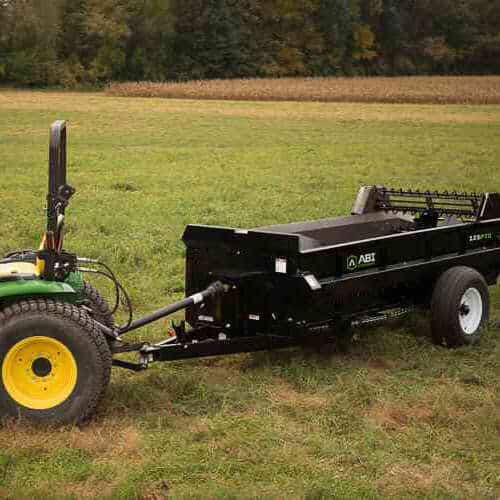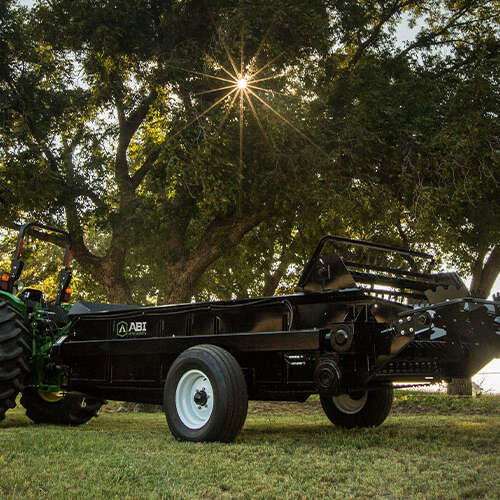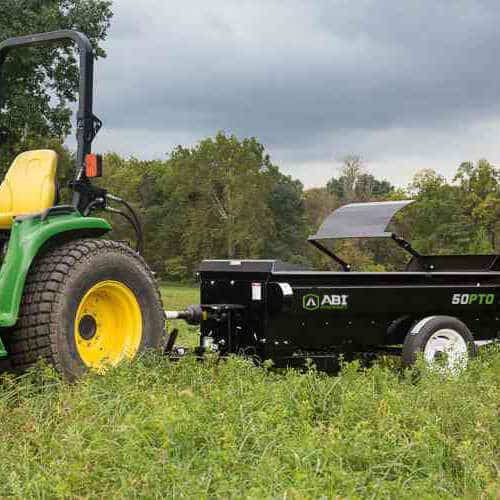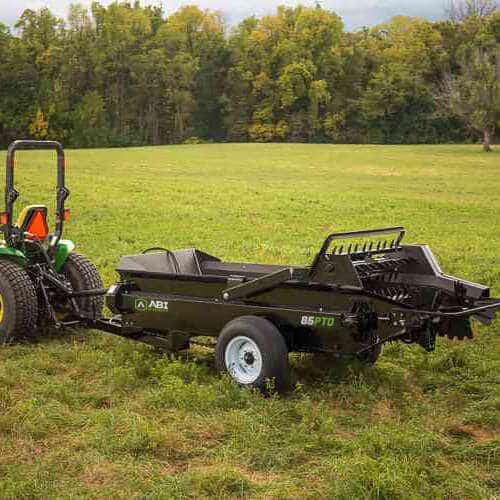Rotation, Rotation, Rotation: The Basics and Benefits of PTO On Our Attachments
The Secret Superpowers of PTO
Let’s talk Tractor PTO! A power take-off system transfers power from the tractor to the attachment it’s pulling without the tractor having to be in motion. In this video, Matt breaks down the basics of what a PTO system does, why some of our tractor attachments use it, and the added benefits it gives you around your property and in the arena.
For more information on these or other attachments visit us at abiattachments.com or call a Product Specialist at 877.788.7253
ABI Products Shown In This Video

125ft³ PTO – Large Manure Spreader
- 4-Speed - PTO Driven
- Min Tractor HP: 35+ HP - Up to 22 Horses
- Starting At: $286/mo.*

185ft³ PTO & Hydraulic – Largest Manure Spreader
- Variable-Speed - PTO/Hydraulic Driven
- Min Tractor HP: 50+ HP - Up to 35 Horses
- Starting At: $376/mo.*

50ft³ PTO – Compact Manure Spreader
- 4-Speed - PTO Driven
- Min Tractor HP: 22+ HP - Up to 8 Horses
- Starting At: $161/mo.*

85ft³ PTO – Mid-Sized Manure Spreader
- 4-Speed - PTO Driven
- Min Tractor HP: 25+ HP - Up to 15 Horses
- Starting At: $240/mo.*
Transcript
Hi, everyone. Matt here with ABI Attachments. Welcome back to the ABI Dirt. Thanks for joining us again, on today’s episode. We’d like to start out the year, this year, by kind of, going back to basics, that there is, we realize, that when it comes to tractors and attachments, and getting work done around your property, that some of you know a lot about a lot of things, and some of you know a little bit about only some things, and that’s okay. And so, that’s why we’d like to stop and say, let’s take a look at something specific, when it comes to tractors and attachments, and let’s go back to, kind of, 101 basics, to help bring some of you up to speed. So today, on the Dirt, we are talking about the PTO system on your tractor.
How Does PTO Work On A Tractor?
So your PTO system, also known as a power takeoff system, is not a new invention, when it comes to tractors and attachments. Actually, there’s records of, kind of, the first brainchilds and innovations of PTO systems in the back of tractors as early as the late 1800s, but it’s actually international harvester, sorry for all of you John Deere fans. It was international harvester, the ones who put a PTO system on the back of the first production tractor in 1918. So yeah, it’s, it’s done proven itself in the past century of work, when it comes to tractors working with attachments.
So if you’re brand new to PTO systems, think of it this way. PTO systems are just about transferring energy from your tractor, to the thing that your tractor is pulling, right? Like, if you think about your lawnmower, right? You’ve got the mower deck of your lawnmower, is up underneath your lawnmower, so the engine on your lawnmower can easily power that mower deck, and it can make the blades turn. But when you’re talking about an attachment, behind a tractor, and attachments can be swapped out, and disconnect this attachment, and attach this attachment, and you’ve got a variety of attachments, you needed some kind of system to make it, so that you can take all of that energy, all of that power, that a tractor’s engine can create, and somehow transfer it back to an attachment. That’s what a PTO system does. And so, you’ve got the PTO shaft out of the back of your tractor, you’ve got then a detachable shaft that connects to the tractor, and goes back to the attachment, so that you can supply power to that attachment.
Some attachments use the PTO system, some don’t, some prefer hydraulics. We’ve got an entire series that you can check out, maybe, that last year actually, if you want to take a look at the difference between power takeoff systems, and hydraulic systems, and electrical systems. But I want to talk through specifically, with some of the attachments we’ve got here at ABI, about why we’ve chosen to use the PTO system for those attachments, and, kind of, the benefit it provides you.
ABI Attachments that Use a PTO System
All right, so the four tools in our, in the ABI attachments lineup, that leverage that PTO system from your tracker is the broadcast-spreader, the dragmaster, the speedmaster, and the pto manure-spreader. Now, what do those four things have in common? Because you’ve got a broadcast-spreader that typically puts down seed and fertilizer across food plots, across pastures. You’ve got the dragmaster and the speedmaster, which are kind of industry-leading arena drags, for larger horse arenas, larger performance arenas, and then, a manure spreader. So, what brings all of those together? Well, it’s the rotational components on those tools, because remember, the PTO system tractor is rotating energy that the strength, the energy, the power from your engine or the tractor, is turning that PTO spine, which is driving rotational energy back to your attachment.
The Broadcast-Spreader
Which means, on a broadcast-spreader you’ve got, not only the kind, the auger inside the hopper, but also that the distribution disc underneath. It’s actually spitting that fertilizer, spitting that seed out upon your, out upon the turf. It’s rotating.
The ABI Speedmaster
You get to the ABI dragmaster and the ABI speedmaster. Well, now that PTO shaft is powering the water pump, so when you’re dragging the arena in a performance scenario, in a high-performance training scenario, and you’re trying to put, around just the right amount of water, then it’s that PTO shaft that’s turning the water pump. It’s the most efficient way to power that water pump for that water distribution unit, the manure-spreader. However, it’s, you’ve got some added advantages there, because yes, the PTO shaft is driving the apron chain, that web drive chain that is pushing the manure to the back of the spreader, so that it can be shredded and spread out the back end.
PTO Powered Manure Spreaders
But you’ve got some uniqueness there, when you’re talking about a PTO drive manure-spreader, compared to a ground drive, because some of you were saying, well, Matt I’ve got a ground drive spreader. It works great. In fact, Matt, I’ve got one of you guys’ ground drive spreaders. And, you’re right, the ground drive manure-spreaders that we’ve got, phenomenal if you’ve got a PTO system on your tractor, if you’ve got a tow vehicle that’s got that PTO system, and if you are someone who wants to compost the manure you’re pulling out of stalls. A PTO-powered manure-spreader gives you an added advantage, because remember, if you are trying to truly compost the manure that you’re pulling out of your barn, then there’s a little bit of work that has to be done, there. It’s going to be worth it, because then you’re going to be putting down some beautiful top soil on top of your pasture. But, if you’re really composting, you need a way that you can control the moisture, and the temperature of that manure pile, sitting out back on your property. And the best way that you can control the moisture, and the temperature, is by rotating that compost.
So, you can park that PTO-powered manure-spreader, load it up, point the rear end really close to the pile you’ve already got, and, as you have that running, you can keep your manure loading in. It takes the compost pile from here, and it spreads it right in position, here, and you can pull it off, because you don’t have to be in motion with the manure-spreader, like you’d have to be, if you had a ground drive manure-spreader. Another benefit to having a PTO drive spreader, as opposed to the ground drive, especially in this season, where, for some of you, it’s just a wet season, and for some of you, it’s a slippery, snowy season. If you’re trying to get manure spread out on slippery pastures, or maybe, it’s soft turf in your pasture, right, and you’re concerned about things getting ratted up. Remember, remember, on a ground drive spreader, you need to have, kind of, those ag tread tires, so it can really get traction. It can dig in, because it’s the, it’s the motion of the tires, and the traction that you get on those tires, that’s going to be pushing your system, powering your system, to shred and spread the manure. But, on a PTO system, the tires can be free-spinning. The, what powers the system, what moves the manure out of your manure-spreader, isn’t the tire itself, it’s the PTO system. So, you don’t have as much grip, and you’re not tearing up soft turf the way you would be on a ground drive spreader. So, it’s actually a whole lot easier to spread on your soft fasteners, and you’ve got less running happening when you do it, unless you think that you need a big, massive tractor, and a big, massive spreader, to take advantage of a PTO system.
Yes, we do have a 185 cubic foot spreader, for those of you who’ve got bigger utility tractors. But if you’ve got a smaller tractor, the PTO spreaders we’ve got around here also come in 125, 85, and 50 cubic foot size model. So, even if you’ve got a compact tractor, we’ve got a size that you can leverage for your free-spreading needs.
Want to Know More About PTO? Send Us Your Questions!
That’s all I’ve got today, everyone. Like I said, this is a bit of a back-to-basics lesson. Some of you, yeah, yeah, yeah. You’ve been working with the PTO systems for years. Some of you, this may be brand new. So, if you are newer to property management, to land management, to tractors and attachments, listen, there’s no such thing as a stupid question around here. We’d love to get your questions in the comments below. If there’s anything else, like, if you think that you don’t know something you wish you knew about your attachment, your tractor, your property, and you just don’t have anyone else to ask, drop it in the comments. We’d love to tackle these things. We would love to help you take care of your property. So, until next time, everyone, take care.



